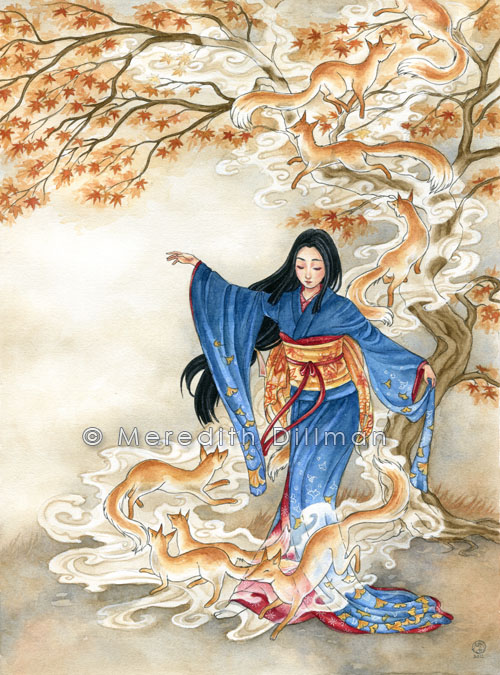 The word ‘Kitsune’ means fox in Japanese, and refers to the use of foxes in Japanese folklore rather than the animal in general. Stories show the Kitsune to be intelligent beings, who possess magical abilities that increase with their age. One such ability is to shapeshift into a human image, which was often used malevolently.
The word ‘Kitsune’ means fox in Japanese, and refers to the use of foxes in Japanese folklore rather than the animal in general. Stories show the Kitsune to be intelligent beings, who possess magical abilities that increase with their age. One such ability is to shapeshift into a human image, which was often used malevolently.
In ancient Japan, foxes and humans lived together which caused a sharp rise in the legends relating to the Kitsune. There were two forms of Kitsune: the ‘Zenko’ and the ‘Yako’ or ‘Youkai’. The Zenko were benevolent and associated with the Inari, a Shinto spirit and would serve as its messengers which reinforced a supernatural influence in the creatures. As the ancient Japanese believed they held an influence, it was common to make offerings to them as you would a deity. However, from the Edo Period (c.1603 -1867), a suspicious nature fell over them which caused the introduction of the ‘Yako’ or ‘Youkai’. These were believed to be malevolent and were considered to be goblins rather than animals.
Kitsune were identifiable by their tails, as it was believed that the more tails that a Kitsune had meant that they were older, wiser and more powerful than the others. 1, 5, 7 and 9 tails were the most commonly seen in Japanese mythology. Legends show that a Kitsune were only able to grow additional tails after living for 100 years. When a Kitsune reached its 9th tail, its fur would become white and gold and it would acquire the power to see and hear anything that was happening anywhere in the world. These foxes, which were now 1000 years old, were referred to as ‘Tenko’, which was the most powerful form of a Kitsune. This is parallel with Chinese mythology, which told of a breed of fox spirit who could have up to 9 tails. Many of these legends were recorded in the Konjaku Monogatarish, which is an 11th century collection of early Chinese, Indian and Japanese narratives. These were adopted into early Buddhist beliefs, which were then introduced to Japanese folklore.
However, some elements of these myths were native to Japan as well. For example, the oldest known usage of the world ‘Kitsune’ is in the 794 CE text of the Shin yaku Kegonky Ongi Shiki. The only known way to kill at Kitsune was to cut off all of its tails. The original tail was believed to be the main one, and thus the source of all of its power. But as a Kitsune grew additional tails it was impossible to determine which was the main, and therefore it was vital that all tails were cut off.
While the ‘Zenko’ Kitsune were benevolent, all Kitsune were often represented as tricksters. Common stories show them playing pranks on the overly proud Samurai, with the malevolent ones abusing poor farming families or devout Buddhist monks. Their victims were usually male, as the Kitsune were believed to either be female, or generally possessed women. They often confused their victims with visions or seduction, and would commonly attack those in retaliation for a perceived slight. In many legends, a Kitsune would pose as a distressed female traveller or monk on a pilgrimage, and would convince a villager to take them in for the night. The next morning, they would find that their food and valuables had been stolen. Alternatively, the Kitsune would seduce its victim into going to a place where they would likely be killed.
A Kitsune was believed to hold items known as ‘Kitsune Balls’ or ‘Star Balls’. These were small, white balls that contained its essence or life force. If you could take the ball from the Kitsune, then you would possess the ability to control the spirit and have it do your bidding. However, should the Kitsune retrieve its ball then you would be subject to the severe repercussions as they did not like to be forcibly controlled.
A Kitsune was such a large part of Japanese culture, that the mental illness ‘Kitsunetsuki’ existed until the early 20th century. Until the 19th century, any physical illness that caused a fever was also believed to be Kitsunetsuki. The disease was believed to be in reference to the state of being possessed by a fox. Its sufferers were usually young women, who believed the fox had entered their bodies either underneath their fingernails or through their breasts. In some cases, it was reported that the victim’s facial expressions would resemble those of a fox. While a woman was suffering from Kitsunetsuki, it was believed that it could cause illiterate victims to gain the ability to read. In order to overcome the disease, an exorcism would be performed at an Inari shrine.
You can learn more about Kitsune here.
LINK TO INCLUDE INSTEAD OF HERE.
-Devon Allen
Junior Girl
Girl Museum Inc.
